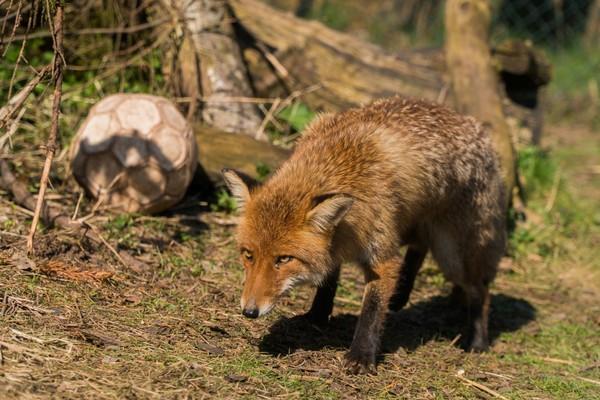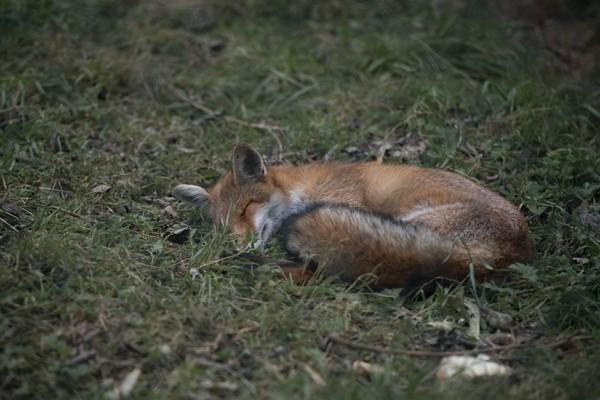
About Foxes – Also Called "Vulpes Vulpes”
The fox is rightly described in many fables and fairy tales as a clever and skillful animal
Foxes belong to the canine family, but also bear a certain resemblance to cats, for example because of their elliptical eyes or because of their typical playing with prey. Adult red foxes weigh about 7 kg, with a body length is about one meter, the shoulder height about 40 cm and the typical bushy fox tail is up to 40 cm long. The fur is reddish-brown in color with a white belly and light tail tip. Typical for the fox are also the high set ears, which help it especially at night when hunting. The fox can still hear a mouse squeak at a distance of 100 m. Foxes can reach a speed of up to 55 km/h and jump up to 5 m far and 2 m high.
Scientific classification
| Order | Carnivora |
| Family | Canidae |
| Genus | Vulpes |
| Species | Vulpes vulpes |
| Binominal name | Vulpes vulpes (Linnaeus, 1758) |
The 'true foxes' form a group within the family of dogs (Canidae). The only representative of this group native to Central Europe is the red fox (Vulpes vulpes).
Besides the genus Vulpes (12 species), Urocyon (grey foxes, 2 species) and Otocyon (bat-eared fox, 1 species) also belong to the true foxes. Biologically, however, the 'foxes' are not a systematic group. Instead, they are species within the Canidae (dogs) that have developed a similar appearance during evolution due to adaptation to a comparable way of life.
The pastel fox is not a distinct biological species and does not occur in the wild at all. Rather, it is a color variant of the red fox specially bred for the cruel fur industry. There are several other color varieties of the red fox in commercial fur farming.
Did you know…?
What is the way of life of a fox?
The fox is predominantly crepuscular and nocturnal. Outside the breeding season in January/February, foxes live solitary lives. During the day, they retreat to hiding places such as rock crevices and overhangs or burrows they have dug themselves. It is not uncommon for foxes to take over badgers' burrows, which have several entrances and exits. Sometimes these are even inhabited by fox and badger at the same time.
Red foxes are omnivores that can adapt their diet to the food supply at short notice. They make do with what is easy to capture and offers a high energy content. The food composition therefore varies locally and seasonally. In general, the fox feeds mainly on mice (up to 90 %). However, earthworms are also readily eaten on grassland areas and offer food rich in fat and protein. The widespread opinion that foxes are natural enemies of hares and roe deer is not entirely correct. As a rule, foxes only prey on young animals or weakened, sick individuals. Usually, they have no chance against healthy, adult animals. Even carrion is not spurned by foxes if necessary. In our ecosystem they play an important role as 'health police of the forest'.
Foxes show a pronounced social behavior. Where they can live undisturbed, they form stable family groups in which parent animals often form a lifelong bond with a single partner. However, human intervention through hunting destroys this social structure. A high mortality rate results in more females participating in reproduction and more cubs born per litter than under stable external conditions. Interestingly, fox populations that are not hunted produce fewer offspring.
Young foxes are born between March and May. The female gives birth to 3-5 pups after a gestation period of about 50 days. They are blind and deaf at first and weigh about 100 g. At the age of 2 weeks, the young ones open their eyes. During the first 6 weeks of life, the pups are supplied with milk by the mother in the burrow, the so-called "kettle". As she rarely leaves the den during the first period after birth, the father supports his mate by bringing in prey and guarding the den. Later, the mother feeds the pups chewed and pre-digested regurgitated meat.
After a few weeks, more and more often mother and offspring leave the den together and go on forays through the territory. At about 5 months of age, the young foxes are finally independent. While young males migrate in the fall to look for their own territory, the females often remain in the family and help raise their siblings in the following year.

Where do foxes live and how many are there?
Red foxes have the largest geographical range of all wild carnivores. They can be found in areas north of the Arctic Circle as well as in almost tropical regions of the earth.
Foxes do not make great demands on their habitat. They inhabit forests of all kinds, structurally rich agricultural areas with hedge strips, but also urban areas with parks and garden plots. The size of the territory is directly related to the availability of resources such as food and mating partners. Territories of 'urban foxes' that find an abundant food supply in a small area (compost heaps, fruit trees in gardens, kitchen waste, food offered to cats or birds outside) can be as small as 0.5 km². However, there are also regions with a low supply of prey, where the territory size of a fox is between 10 and 50 km². The territorial boundaries are marked with faeces, urine and the secretion from the anal gland.
If the competitive pressure, e.g. for food resources in a territory, becomes too great, foxes react to this with a reduced birth rate. The population thus regulates itself continuously in a natural way.

Foxes at the TIERART Wild Animal Sanctuary
Every year TIERART takes in injured and orphaned fox cubs - the stories behind the animals are very different. The 'fox season' begins in March/April: usually, the cubs are brought to us after being found somewhere without a mother or siblings.
But cubs do not always actually need help just because they are apparently alone and 'abandoned'. As soon as the cubs are a few weeks old, they leave the den with their mother and go on roaming expeditions. It is not uncommon for a particularly curious offspring to wander a little further away from the family on such expeditions and then be tracked down by walkers or their dogs. As a general rule, wild animals must not be disturbed, touched or even taken away without a serious reason. So if the young animal does not look sick, injured or otherwise abnormal, you should quickly move away from its surroundings. The mother is usually close by, but will not return to her offspring until she feels undisturbed.
The situation is of course different if, for example, the mother animal is run over on the road and the puppies are wandering around there. Without human help, they would certainly have no chance of survival.
Young animals that have been hit by a car, animals with bite wounds caused by dogs or animals that have been mistaken for abandoned puppies also come to TIERART time and again. Here they receive medical care or are reared and prepared for later reintroduction into the wild.

What happens to the cubs at TIERART?
On arrival at our sanctuary, each individual animal is thoroughly examined, weighed, checked for parasites and injuries and then cared for according to its needs. Very young animals are monitored around the clock by our animal caretakers and, depending on their age, are fed with a special replacement milk for cubs at more or less regular intervals. As soon as they start eating solid food on their own, they are brought together in groups into species-appropriate enclosures where they can gradually be completely weaned off humans again until they are released into the wild in autumn. Here we offer the young foxes sufficient hiding places and, above all, food appropriate to their species. We want them to get used to their future main food, namely mice, as quickly as possible. In addition, our foxes are of course regularly dewormed and vaccinated against disease like parvovirus and rabies, so that they will have the best possible conditions for a second chance of survival in the wild.
Note: Any advertisements that may appear during the viewing of this video are unrelated to FOUR PAWS. We assume no liability for this content.
Puppies become foxes – and then?
In September, the time has finally come to release the foxes back into the wild. In small groups of 2-3 animals, we take them to suitable forest areas, far away from villages and busy roads, after consultation with the responsible hunting authority. Fortunately, the cooperation with hunters and foresters as well as with the local nature conservation authority works very well. In the meantime, we also count some 'fox-friendly' hunters among our association members and supporters, who completely renounce fox hunting in their hunting grounds and are happy about the occurrence of the fox. After all, it plays an important role in our ecosystem as the 'health police of the forest'. On the one hand, it usually feeds on almost 90% of mice, which, if they become too numerous, can also transmit diseases or cause crop damage. On the other hand, foxes also take sick or decrepit animals such as deer or hares from the population or feed on carrion.




